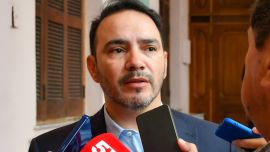All last year the Carlos Menem Presidency was the closest thing in previous experience to providing a template for the disruptive novelty of Javier Milei’s libertarian/anarcho-capitalist administration (with the two-term president’s nephew the current Congress Speaker, no less) but the return of Donald Trump to the White House invites new comparisons, given the “carnal relations” with Washington uniquely boasted by Menem – even if Milei has just dumped Rodolfo Barra (handpicked for the Supreme Court and the Justice Ministry by Menem) as his Treasury attorney.
Hard to tell which of the two five-letter surnames beginning with “M” is or was keener on being on the right side of Washington but we now inhabit not only a different century but also millennium with a similar relationship being pursued in a changed (and changing) world. Menem became president just 31 days after the fall of the Berlin Wall in 1989 with the Cold War won, “the end of history” and the United States ruling supreme – Trump’s campaign MAGA slogan of “Make America Great Again” is a blunt admission of dwindling US global power with China’s Artificial Intelligence mounting an unexpectedly early and more cost-efficient challenge at the start of this week. At the time Menem was the first democratically elected Argentine president to replace an equally legitimate predecessor since 1928 whereas today Milei can also be seen as a symptom of a growing disenchantment with normal democratic politics more than four decades after their return.
The presidents are also different – what a contrast between Bill Clinton proclaiming the Free Trade Area of the Americas at the Miami Summit of the Americas in 1994 and a protectionist Trump (who shunned the 2018 edition of that Summit) with his “We don’t need them” dismissal of Latin America on the day of his inauguration! Another contrast between Clinton and Trump would be the former being perhaps the most fiscally correct US president in recent history while the latter has been one of the most reckless. Since Milei is super-correct in this area with over a year of fiscal surpluses and since he is avidly pursuing a free-trade agreement with Big Brother, there is a mismatch which would seem to belie the ideological alignment between the Republican tycoon and the libertarian – indeed Milei’s Davos harangue replacing last year’s “socialism” with a word so alien to any Latin American language as “woke” as the great bugbear may not have been so much falling in line with The Donald as having no other option, given the lack of overlap in economic agenda.
What then and now do have in common in the economic sphere is an overvalued currency between crawling peg and convertibility (whose demise was hastened by Clinton being fiscally solid since dollar-peso parity was undermined by Menem never balancing his budgets with not even a primary fiscal surplus in half his 10 years). Ideological compatibility can be overrated but also underestimated, making it no accident that Washington should be most ardently wooed under Menem and Milei. The former may not have identified with his counterparts as strongly as Milei with Trump but closely enough – plenty of rapport between Menem and the elder George Bush, who visited Argentina in late 1990 and flatteringly dubbed Menem “a world leader,” while the La Rioja Peronist and the Democrat Clinton, who overlapped with 70 percent of his presidency, had in common representing the more orthodox wing of the less orthodox party.
Turning to the region, the generation between 1990 and 2025 has altered the political landscape. The South America of the 1990s usually had something resembling a two-party system generally tilting towards the right. This was certainly true of pre-Lula Brazil where the prestige achieved by Fernando Henrique Cardoso contrasted with the disrepute into which Fernando Collor de Mello fell but both were centre-right. The Colombia and pre-Chávez Venezuela of that period may have included the mayhem of Pablo Escobar and the 1989 Caracazo respectively but against a steady political backdrop of alternation between the Conservative and Liberal Parties (Colombia) and the centre-left Acción Democrática and the Copei Christian Democrats (Venezuela). This was the decade of the late Alberto Fujimori in Peru and the centre-left Concertación coalition (always then headed by a Christian Democrat) in Chile while Alfredo Stroessner may have been overthrown in Paraguay in 1989 but always a Colorado president. Ecuador was fairly normal until Abdalá Bucaram (the Artist Formerly Known as President from his rock star aspirations) was declared insane in 1997, leading to a period of instability until the advent of dollarisation in 2000. Bolivia moved constantly towards the right in a decade beginning with the revolutionary leftist Jaime Paz Zamora and ending with the ex-dictator Hugo Banzer as elected president, even more rightist than his predecessor Gonzalo Sánchez de Losada (who spoke Spanish with a Yankee accent). Last but not least, when has Uruguay (presided in that period by the Blanco Luis Lacalle Herrera and the Colorado Julio María Sanguinetti) ever been anything but normal?
Today the name of the game is fragmentation with a general trend against ruling parties amid the evaporation of incumbent advantages. Bolivia, Chile and Ecuador all go to the polls this year with a shift towards the opposite end of the spectrum possible in all three cases but until then Milei does not have much far right company in the subcontinent these days – more or less limited to Ecuador’s youthful Daniel Noboa (a fellow-guest at Trump’s inauguration) once the younger Lacalle leaves office in Uruguay with all the others at least nominally leftist apart from Paraguay’s eternally Colorado president (now Santiago Peña). A region in flux which now has to come to terms with Trump.
And so it begins. Still very early days to see if the forces of heaven can stoop (or ascend) to the “carnal relations” with the United States so celebrated by Menem.






















Comments